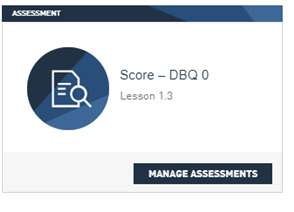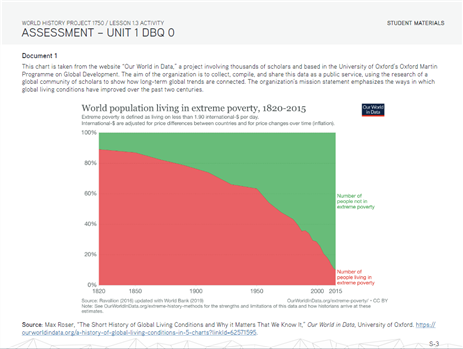By the OER Project Team
It’s the moment you’ve all been waiting for—well, maybe not the moment you’ve been waiting for because an end to the pandemic would be way better, but it is pretty exciting news. The World History Project (WHP) writing progression activities and assessments are now live on the OER Project website! To mark this event, we thought that a blog post explaining the progression activities, assessments, and Score submission process would be welcomed by all.
The writing progression activities start with an introduction to the WHP Writing Rubric, which is the same rubric by which students will be assessed throughout the year. Each activity is designed to help students not only understand the rubric criteria, but also learn how to identify the elements of good writing. Students will learn about how to craft a thesis statement and maintain focus throughout an essay. They’ll also identify evidence in essays and learn how the use of evidence must be coupled with analysis and then connect back to the thesis or major claim of the essay. Then, students will progress to identifying how organization and style help authors convey their arguments. And since we’re focusing on concepts and content in WHP, we teach students how to integrate these key concepts into their essays to help support the thesis.
For the writing progression activities in the later units or eras of the course, we ask students to do a deeper analysis of sample essays. They will shift from simply identifying elements such as the major claim and evidence, to attempting to make suggestions for improvement in the sample essays. This will help students develop these core writing skills so that they are prepared to construct their own historical narratives in response to historical prompts. (To find out information about the BHP writing progression, click here.)
This brings us to the actual writing assessments in the course. At the end of each era or unit, students are asked to respond to a historical prompt by answering a long essay question (LEQ) or a document-based question (DBQ). The course includes a variety of prompts, such as those related to causation, comparison, and continuity and change over time (CCOT). In addition, to help students understand what these historical prompts are actually asking them to do, we’ve included a Question Parsing Tool and a number of activities that have them break down prompts into their own words and determine which historical thinking practice is being referenced. And since the historical thinking practices of contextualization and sourcing are essential when responding to historical prompts, we’ve also included tools and instructions for students to help guide them through the process of crafting essays that are sure to blow you away!

Now, at the OER Project, we’re also big on making teachers lives a bit easier, so we’ve included access to Score for a few DBQs in the course. The first DBQ of the course—DBQ 0—is the baseline assessment that will help give you an idea of your students’ writing abilities at the beginning of the school year. They’ll see the same DBQ at the end of the course in Era 7/Unit 9, which will allow you (and them) to see just how much they’ve grown as historical writers over the course of the year. You also have the ability to submit DBQ 5 to Score as a midpoint assessment to check for growth and amend instruction according to your students’ needs. It’s important to note that we use DBQ 0 and Era 7/Unit 9 for research purposes, which means that the data collected will help to improve the WHP course year after year. As a result, we ask that you follow all of the directions outlined in these assessments so that we can get a clear and accurate picture of how student writing is advancing.

You’ll see that students can submit their essay responses to all the other DBQ and LEQ assignments via the OER Project site. We’re collecting these in order to train the scoring machine so that we can offer even more Score assessments! Note that when students submit the non-Score assessments, they should first draft these in a word-processing tool (Microsoft Word or Google Docs, for example) and copy and paste their final essays into the submission form on the OER Project site. The form will not save their work as they write, so if they leave the browser, they will lose their work! Just as important, note that you will not be able to see what they submit, so it’s crucial that they send you their final essay as well as submit to Score via the form.
As always, we really love to hear your feedback on any or all of these activities and assessments. Start a conversation in the Community and share your thoughts with other teachers too.
Happy start of the school year and let’s get students writing!
Header image: Annie Spratt (Unsplash)
 For full access to all OER Project resources AND our amazing teacher community,
For full access to all OER Project resources AND our amazing teacher community, 
-

Deborah Hoggan
-
Cancel
-
Up
0
Down
-
-
Reply
-
More
-
Cancel
Comment-

Deborah Hoggan
-
Cancel
-
Up
0
Down
-
-
Reply
-
More
-
Cancel
Children